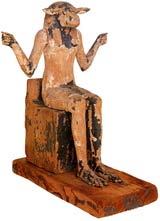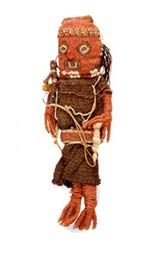| |
|
 |
 |
 |
 |
A Kind of Magic - Talismans, charms and amulets from The British Museum
- Gallery 4, Henry Moore Institute, Leeds, curated by James Putnam and Stephen Feeke. 2 April - 29 June 2003
From the earliest times, talismans, charms and amulets have been held in
high esteem by all cultures as transmitters of good luck and to avert
misfortune. Prehistoric man seems to have adopted them as a result of an
internal urge or natural instinct to protect his body against harm.
Probably the earliest form of amulets were the claws and teeth of lions and
tigers and other powerful animals, carried because they would add strength
in fighting wild beasts and enemies. Their descendants throughout the world
have used them for common reasons. Amulets and talismans conveyed joy and
confidence to their owners, and were thought to give warning of coming
events, inspiring courage and faith in the fearful. It was believed that
their possession enabled children to be conceived, provided strength to
overcome enemies, both visible and invisible. Above all they were a means of
protection for families, households and livestock from harmful forces
Most amulets and talismans derived their protective powers from the images
of gods, sacred animals and symbols either engraved or drawn on them .
Similarly inscriptions, consist of sacred and divine names used as words of
power and spells which represent ideas and beliefs. All these amulets appeal
to the divine powers for fertility, preservation of the family, success, the triumph of good
over evil, law over chaos, light over darkness. It was believed that the materials from which
amulets and talismans were made possessed certain qualities, attributes or powers. The influences
of the inscription, device, name or word of power which was written upon the amulet, supplemented
and perhaps increased the inherent power of the material. To this there was the added power of the
good will or affection or love of the giver of the amulet. When the firm belief of the wearer
reinforced the quality of the amulet, it could no longer be regarded as merely inert matter and
became a "working" amulet. In this way a dose of medicine might be regarded as an amulet applied
internally, where the effect of its substance was supplemented by the spell or prayer. Together
with the good will and faith of the patient this had a more curative power .
The insatiable desire to know the future was and still is a deep-rooted instinct in man,
and many kinds of fortune telling were practised since the earliest times. Besides using cards
and palmistry, Clairvoyants tell the future by staring into liquids, crystals and mirrors.
Nowadays astrologers, makers of horoscopes and diviners still use amulets particularly in Egypt,
the Sudan and the Near East. The universal use of amulets is due to the human belief in the existence
of demons, evil spirits and negative forces.
Man's fear brought amulets into being, and that it is only his belief which
endows them with power, and his implicit and invincible faith which makes
them operative. No amount of development, culture or education will make
humans abandon wholly the use of amulets and talismans since they give their
wearers a sense of comfort and protection and well being.
Selected Images:
1st picture from top: Ram- Headed Deity from a tomb
Painted wood, from the Valley of the Kings, Thebes, Egypt
End of the 18th Dynasty, around 1325 BC
This figure represents one of the servants of Osiris, ruler of the Underworld and was intended to protect the king on his journey to the Afterlife.
2nd picture from top: Textile Doll
Tapestry, cloth and reed
Valley of Pacasmayo, Peru
1,000-1476 AD
From a Peruvian grave this may have had ritual significance to bring good luck to the dead
|
|
 |
 |
Ram- Headed Deity from a tomb
|
 |
 |
Textile Doll
|

|
 |
 |
|
|
|